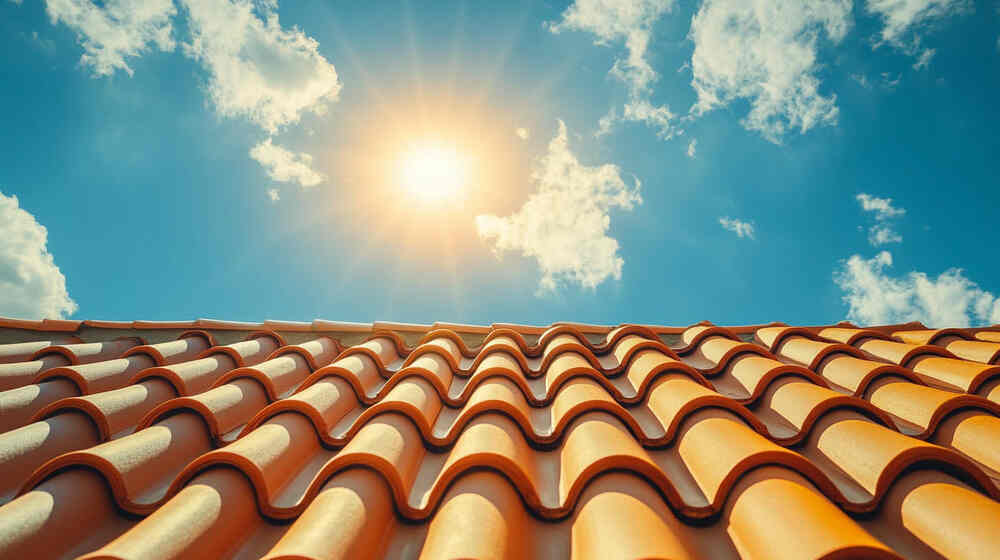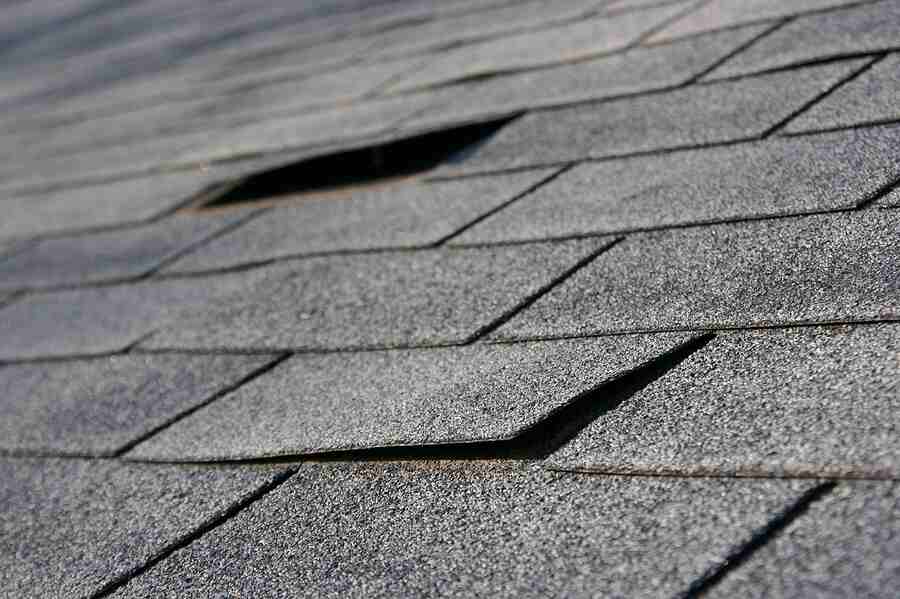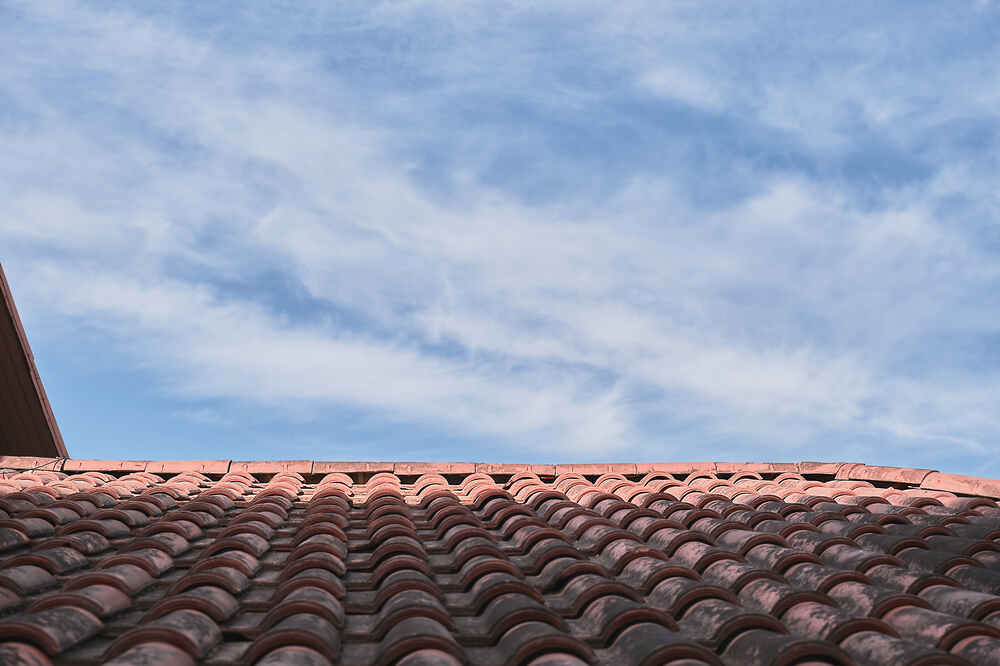Roofs endure constant exposure to the elements, but one of the most damaging forces is the sun. Over time, prolonged exposure to ultraviolet (UV) rays, high temperatures, and thermal fluctuations can lead to roof damage that weakens structural integrity and reduces energy efficiency. Understanding the signs of sun damage and implementing protective measures can help homeowners avoid costly roof repair services and extend the lifespan of their roofing system.
Table of Contents
Key Takeaways✔ UV rays break down roofing materials, causing shingles and tiles to fade, which may indicate deeper deterioration and the need for roof damage repair. ✔ Heat causes shingles to dry out and lose flexibility, making them prone to curling, cracking, and exposing the underlayment to moisture, leading to emergency roof repair. ✔ Prolonged sun exposure dries out roofing materials, making them fragile and prone to breaking, increasing the risk of leaks and requiring roof repair services. ✔ Constant heating and cooling cycles cause roofing materials to expand and contract, leading to loosened fasteners, gaps, and structural weakness, necessitating roof damage repair. ✔ Sun exposure weakens sealants and flashing, causing them to crack or peel, creating entry points for water infiltration that demand roofing repair. ✔ A sun-damaged roof absorbs excess heat, reducing insulation efficiency, increasing cooling costs, and signaling the need for roof repair services to improve energy efficiency. |

How Sun Exposure Affects Your Roof
Sunlight, while essential for life, can be incredibly harmful to roofing materials. UV rays, heat, and rapid temperature changes contribute to roof damage, breaking down protective layers and leading to deterioration.
- UV Rays and Material Degradation: UV radiation weakens roofing materials by breaking down their chemical bonds. Over time, asphalt shingles lose their protective granules, wood shakes dry out and crack, and metal roofs may experience oxidation or fading.
- Thermal Expansion and Contraction: Roofing materials expand when exposed to extreme heat and contract as they cool. This cycle of expansion and contraction creates stress on the roof, causing materials to warp, crack, or loosen.
- Loss of Energy Efficiency: Sun-damaged roofs absorb more heat, making homes warmer and increasing cooling costs. Poorly maintained roofs often result in higher energy bills and reduced indoor comfort.
6 Common Signs of Sun Damage on Your Roof
Recognizing roof damage early allows homeowners to seek roof repair services before problems escalate. Sun-related wear and tear may not be immediately obvious, but gradual changes in the roof’s appearance and performance signal a need for attention. Below are some of the most common indicators that a roof has sustained sun damage and requires roofing repair.
1. Fading or Discoloration
Fading is often one of the first noticeable signs of sun damage. Over time, constant exposure to UV rays causes roofing materials to lose their vibrant color. Dark-colored shingles may appear washed out, while lighter or earth-toned tiles may look dull and lifeless.
- Why It Matters: While fading itself is primarily a cosmetic issue, it often indicates deeper deterioration. The loss of color suggests that protective granules on asphalt shingles have worn away, leaving the material vulnerable to roof damage.
- Warning Signs: Uneven discoloration, streaking, or patches of lighter and darker shades may indicate that some sections of the roof are more severely affected than others. This could lead to premature roof damage repair needs.
- Materials at Risk: Asphalt shingles, wood shakes, and composite roofing materials tend to fade faster than metal or clay tiles, which are more resistant to UV exposure.
2. Cracked, Warped, or Curling Shingles
Sun exposure can cause shingles to dry out and lose their flexibility. Heat breaks down the oils in roofing materials, causing them to become brittle and deformed.
- Why It Matters: Curled or warped shingles no longer lay flat against the roof, exposing the underlayment and making it easier for moisture to seep in. If left unaddressed, this can lead to severe water damage and the need for emergency roof repair.
- Warning Signs: Look for shingles that have raised edges, are curving upward, or have visible cracks. These signs suggest that the materials are deteriorating and losing their ability to protect the roof.
- Materials at Risk: Asphalt shingles are the most prone to curling and cracking under extreme heat, though composite roofing materials may also exhibit similar issues over time.
3. Brittle or Weakened Roofing Materials
Over time, UV exposure breaks down the molecular structure of roofing materials, making them dry and brittle. When this happens, shingles, tiles, and shakes become fragile and susceptible to cracking or breaking under minimal pressure.
- Why It Matters: Brittle shingles are not just a surface-level issue. Once they begin to crack, they lose their ability to repel water, leading to leaks and structural degradation. In severe cases, widespread brittleness may require extensive roof repair services.
- Warning Signs: Shingles that crumble when touched or easily snap during routine maintenance indicate a loss of flexibility and durability. Homeowners should also look for small granules accumulating in gutters, as this suggests that the roofing material is deteriorating.
- Materials at Risk: Asphalt and wood shingles tend to become brittle faster than metal or slate roofing, which is more heat-resistant.
4. Thermal Expansion and Contraction
Roofing materials constantly expand and contract due to temperature fluctuations, particularly in regions with extreme heat during the day and cooler temperatures at night. This movement creates stress that weakens structural integrity over time.
- Why It Matters: Continuous expansion and contraction cause materials to shift and pull apart. This results in loose fasteners, separated seams, and gaps that allow moisture intrusion. If left untreated, small cracks can lead to severe roof damage repair needs.
- Warning Signs: Homeowners should watch for slight misalignment in shingles, visible gaps between panels, or nails that have backed out from their original positions. These signs suggest that the roof is undergoing structural strain.
- Materials at Risk: Metal roofs are particularly prone to expansion and contraction, though asphalt shingles may also develop cracks or curling edges from repeated stress.
5. Deterioration of Sealants and Flashing
Flashing and sealants play an essential role in keeping water from entering vulnerable areas such as chimneys, skylights, and vent pipes. However, exposure to high temperatures can cause these materials to degrade, crack, or lose their adhesive properties.
- Why It Matters: When flashing becomes brittle or peels away from surfaces, it creates gaps that allow water to penetrate the roof. This leads to moisture buildup, leaks, and costly roof damage repair.
- Warning Signs: Look for visible cracks in the sealant, gaps where the flashing has pulled away, or areas where previous repairs have started to fail. Rusting or corrosion around metal flashing is also a sign of prolonged sun damage.
- Materials at Risk: Rubberized sealants and adhesives degrade faster than metal flashing, though both require periodic maintenance to remain effective.
6. Higher Energy Bills
A sun-damaged roof doesn’t just affect structural integrity—it also impacts energy efficiency. Roofing materials that have lost their reflective properties absorb more heat, making it harder to maintain indoor temperatures.
- Why It Matters: As heat becomes trapped inside the home, air conditioning systems must work harder to maintain a comfortable temperature. This increases energy consumption and results in higher utility bills. Addressing roofing repair needs can improve insulation and lower energy costs.
- Warning Signs: Homeowners may notice that rooms under the attic are warmer than the rest of the house, or that cooling costs have increased without an apparent reason. These could be signs of a heat-absorbing, sun-damaged roof.
- Materials at Risk: Dark-colored shingles and traditional asphalt roofs are more likely to absorb excess heat compared to reflective or cool roofing materials.
How to Protect Your Roof from Sun Damage
Taking proactive steps to protect a roof from sun exposure is essential to extending its lifespan and minimizing the need for roof repair services. By implementing preventive measures, homeowners can reduce long-term maintenance costs and maintain a durable, energy-efficient home.
1. Choose Sun-Resistant Roofing Materials
The right roofing material plays a significant role in how well a roof withstands heat and UV exposure. Certain materials are designed to handle intense sunlight better than others, providing enhanced durability and reducing the frequency of roof damage repair. Homeowners considering roof repair services or replacements should consult with professionals to choose the best sun-resistant materials for their climate and home structure.
- Asphalt Shingles: In 2020, asphalt shingles made up around 64% of the residential roofing market, maintaining their position as the most widely used roofing material in North America. While asphalt shingles are affordable and easy to install, they are also highly susceptible to sun damage, with prolonged UV exposure causing them to fade, crack, and lose protective granules.
- Metal Roofs: Reflective and durable, metal roofs can withstand extreme temperatures and prolonged UV exposure better than many other materials. They also cool down quickly, helping to prevent heat buildup in the attic. Metal roofs are almost entirely recyclable and contain at least 25% recycled materials, making them an eco-friendly roofing option.
- Clay or Concrete Tiles: These materials naturally resist heat absorption, keeping roofs cooler in hot climates. Their dense composition also provides long-term durability. While they are heavier than other materials, they offer superior longevity and require fewer roof repairs over time.
- Cool Roofing Technology: Some modern shingles feature built-in reflective coatings or are made with UV-resistant materials that prevent excessive heat retention. These materials help lower indoor temperatures and reduce the risk of roof damage caused by overheating.
- Synthetic Roofing Materials: Advanced synthetic shingles and composite roofing materials mimic the appearance of traditional materials while offering better resistance to UV rays and thermal expansion.
2. Apply Protective Coatings
Even if a roof is made from a sun-resistant material, applying a protective coating can further enhance its durability. Coatings act as a shield, reducing the impact of UV rays and prolonging the life of roofing materials.
- Reflective Coatings: These coatings reduce heat absorption by reflecting sunlight. They are particularly beneficial for asphalt shingles and metal roofs, helping to lower cooling costs and minimize roof damage repair.
- UV-Resistant Sealants: Over time, exposure to direct sunlight can cause roofing materials to dry out and crack. UV-resistant sealants help maintain flexibility, preventing shingles and flashing from becoming brittle.
- Waterproof Coatings: Some coatings provide additional moisture protection, which is particularly useful for climates that experience both extreme heat and seasonal rains. A properly sealed roof is less likely to suffer from roof damage caused by expanding and contracting materials.
3. Ensure Proper Ventilation and Insulation
Proper ventilation and insulation are crucial for regulating roof temperature and preventing unnecessary roofing repair due to sun exposure. Without adequate airflow, heat can become trapped in the attic, accelerating the deterioration of roofing materials. Regularly checking attic vents and ensuring insulation meets industry standards can significantly reduce the likelihood of roof repair services caused by sun damage.
- Attic Ventilation: A well-ventilated attic allows hot air to escape, preventing excess heat buildup under the roof. Ridge vents, soffit vents, and attic fans help maintain proper air circulation.
- Insulation Benefits: High-quality insulation keeps indoor temperatures stable by reducing heat transfer from the roof to the rest of the house. This helps prevent premature roof damage repair and lowers cooling costs.
- Preventing Condensation: In addition to managing heat, good ventilation prevents moisture buildup that could weaken roofing materials over time. Combining proper insulation with ventilation creates a balanced system that reduces strain on the roof.
4. Schedule Regular Roof Inspections
Routine roof inspections are one of the most effective ways to prevent roof damage and avoid costly emergency roof repair situations. Professional roofers can identify small issues before they escalate into major structural problems.
- Annual Inspections: Homeowners should schedule at least one roof inspection per year, preferably before peak summer heat. This helps detect minor signs of sun damage, such as drying shingles or deteriorating flashing.
- Post-Storm Assessments: If a region experiences extreme heat followed by storms, it is advisable to have the roof checked for any newly developed roof damage. The combination of intense sun exposure and heavy rainfall can accelerate wear.
- Identifying Weak Spots: Roofing professionals can assess areas prone to excessive sun exposure, such as roof valleys and south-facing sections. Addressing these issues promptly can prevent expensive roof damage repair later.
- Preventative Repairs: If minor cracks or weakened sealants are found, addressing them immediately can extend the life of the roof and reduce the frequency of roof repair services.
5. Trim Overhanging Trees
While trees provide natural shade, overgrown branches can also pose a risk to roofing materials. Properly maintained landscaping can reduce roof damage while maintaining cooling benefits. Regular tree trimming and gutter maintenance help homeowners avoid unnecessary roof repair services caused by neglected landscaping.
- Shade Benefits: Strategically placed trees can lower roof temperatures, reducing heat absorption and slowing material degradation. However, trees must be trimmed regularly to prevent debris buildup.
- Preventing Debris Accumulation: Fallen leaves, twigs, and branches can trap moisture on the roof, leading to mold growth and premature roof damage repair. Keeping the roof clear reduces this risk.
- Avoiding Physical Damage: Branches that scrape against shingles can wear down protective granules, making the roof more vulnerable to sun damage. In severe cases, falling limbs can cause emergency roof repair needs.
- Encouraging Proper Drainage: A clear roof allows water to drain properly. Blocked gutters from tree debris can cause water to back up, increasing the likelihood of leaks and roofing repair requirements.
6. Replace Aging or Damaged Roofing Materials
Even with preventative measures, no roofing material lasts forever. When a roof becomes significantly weakened by sun exposure, replacing old or damaged sections can prevent larger problems. A professional roof repair services provider can help determine the best approach for replacing damaged sections while ensuring long-term durability.
- Knowing When to Replace: If a roof has excessive cracking, curling, or brittle shingles, a professional assessment can determine if roof damage repair is sufficient or if full replacement is necessary.
- Energy-Efficient Upgrades: Replacing outdated shingles with modern, reflective materials can improve a home’s energy efficiency and reduce cooling costs.
- Extending Roof Lifespan: Rather than waiting for a major issue, homeowners can plan gradual replacements in sections to spread out the cost while maintaining a functional roof.
- Avoiding Emergency Repairs: Proactively replacing aging materials prevents the risk of sudden failures that require emergency roof repair.
How to Choose a Trusted Roofing Company
Hiring an experienced roofing company ensures that repairs and maintenance are handled professionally, preventing unnecessary emergency roof repair situations.
1. Look for Experience and Expertise
An established roofing company understands how to address sun damage effectively. Hiring professionals with a proven track record ensures high-quality roof repair services.
2. Check Reviews and References
Customer reviews, testimonials, and word-of-mouth recommendations help homeowners choose reputable contractors. Checking references provides insight into the quality of roofing repair work.
3. Verify Licensing and Insurance
A licensed and insured roofing company protects homeowners from liability and guarantees compliance with safety standards. Avoiding uninsured contractors reduces risks associated with roof damage repair.
4. Request a Detailed Estimate
A written estimate should outline labor costs, materials, and project timelines. Clear estimates prevent hidden charges and ensure transparency in roofing repair costs.
5. Ask About Warranties and Maintenance Plans
Reliable roofing companies offer warranties on materials and labor. Maintenance plans provide scheduled inspections and roof repair services, reducing the likelihood of emergency roof repair needs.
Frequently Asked Questions
How long does a typical roof last before needing repairs?
The lifespan of a roof depends on the material, climate, and maintenance. Asphalt shingles last about 20-30 years, while metal and tile roofs can last 50 years or more. Regular inspections and timely repairs can help extend a roof’s lifespan.
What are the most common causes of roof leaks?
Roof leaks are often caused by damaged or missing shingles, cracked flashing, or clogged gutters. Poor installation and aging materials can also contribute to leaks over time. Addressing small leaks quickly can prevent costly structural damage.
Can I perform roof repairs myself, or should I hire a professional?
Minor repairs, like replacing a single shingle, can sometimes be done by homeowners with proper safety precautions. However, major repairs involving structural damage, leaks, or flashing should be handled by professionals. Hiring an expert ensures quality workmanship and reduces the risk of further damage or personal injury.
How can I tell if my roof has poor ventilation?
Signs of poor roof ventilation include excessive attic heat, mold growth, and ice dams in colder months. High energy bills and a musty odor inside the home can also indicate ventilation problems. Proper airflow helps regulate temperature and prevents premature roof deterioration.
Does homeowners insurance cover roof repair?
Homeowners insurance typically covers roof repair for damage caused by storms, falling debris, or other sudden events. However, it usually does not cover repairs due to normal wear and tear or lack of maintenance. Reviewing your policy and scheduling regular inspections can help prevent unexpected repair costs.
Get Expert Roof Repair Services in NY — Call Roofer of Pleasant Valley!
Don’t wait until minor roof damage turns into costly repairs—protect your home with professional roof repair services from Roofer of Pleasant Valley. As the trusted roofing experts in Pleasant Valley, NY, we specialize in identifying and fixing sun damage, leaks, and structural wear before it becomes a bigger problem. Whether you need routine maintenance, emergency repairs, or a full roof replacement, Roofer of Pleasant Valley provides reliable and high-quality service tailored to your home’s needs.
If you’re looking for a dependable roofing contractor in Pleasant Valley, NY, reach out to Roofer of Pleasant Valley today for a free consultation and keep your roof in top condition!


